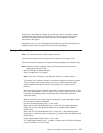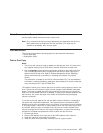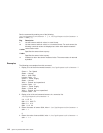
To prevent problems that can occur when running this service aid from disk, it is
suggested that this service aid be run, when possible, from the diagnostics that are
loaded from removable media.
Display/Alter Sector
Note: Use caution when you use this service aid because inappropriate modification to
some disk sectors can result in the total loss of all data on the disk.
This selection allows the user to display and alter information on a disk sector. Sectors
are addressed by their decimal sector number. Data is displayed both in hex and in
ASCII. To prevent corrupted data from being incorrectly corrected, the service aid does
not display information that cannot be read correctly.
Display Configuration and Resource List
If a device is not included in the Test List or if you think a Diagnostic Package for a
device is not loaded, check by using the Display Configuration and Resource List task.
If the device you want to test has a plus (+) sign or a minus (-) sign preceding its name,
the Diagnostic Package is loaded. If the device has an asterisk (*) preceding its name,
the Diagnostic Package for the device is not loaded or is not available.
This service aid displays the item header only for all installed resources. Use this
service aid when there is no need to see the vital product data (VPD). (No VPD is
displayed.)
Display Firmware Device Node Information
Note: This service aid runs on CHRP system units only.
This task displays the firmware device node information that appears on CHRP
platforms. This service aid is intended to gather more information about individual or
particular devices on the system. The format of the output data may differ depending on
which level of the AIX operating system is installed.
Display Hardware Error Report
This service aid uses the errpt command to view the hardware error log.
The Display Error Summary and Display Error Detail selection provide the same type of
report as the errpt command. The Display Error Analysis Summary and Display Error
Analysis Detail selection provide additional analysis.
108 Eserver pSeries 690 User’s Guide


















